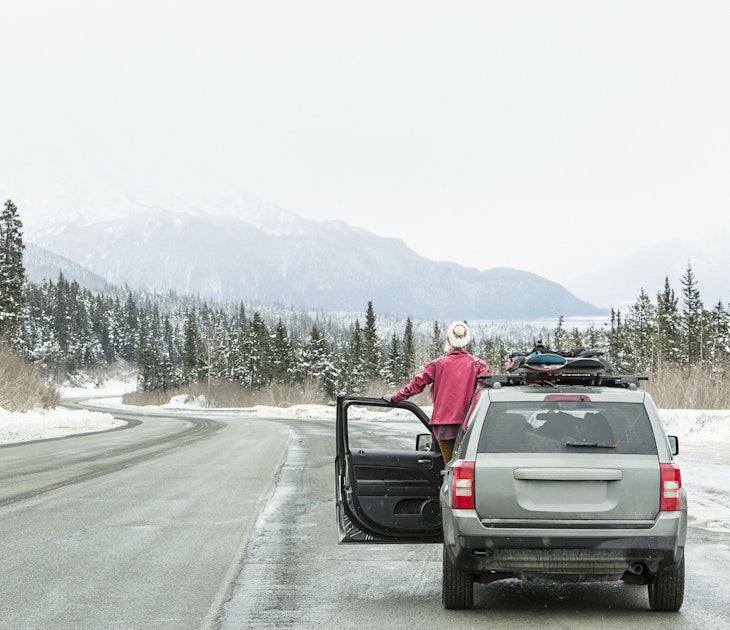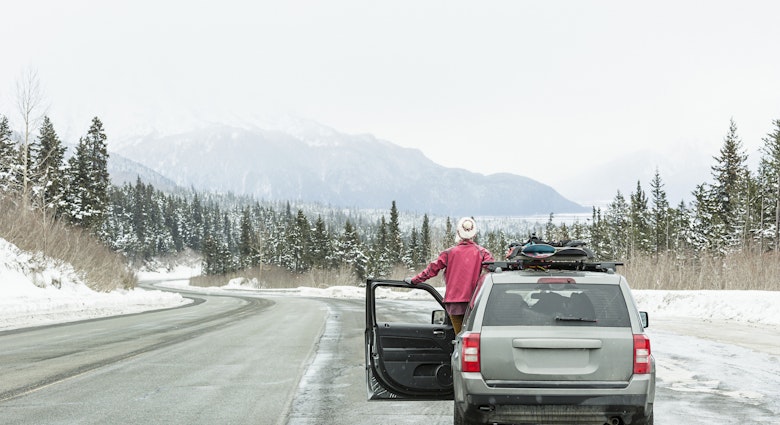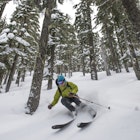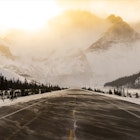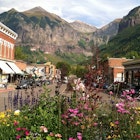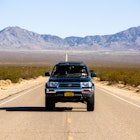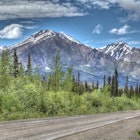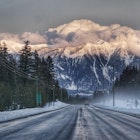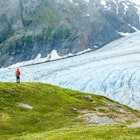Until an incredible cross-country railway united its east and west coasts, Canada was largely an unpopulated wilderness. Lonely Planet Traveller author Tim Moore takes to the rails to discover how steel tracks unlocked the nation’s dramatic interior. Photographs by Pete Seaward.
Canada's cross-country rail snakes from the craggy peaks of the Rockies to the sprawling farmlands of Saskatchewan. Image by Pete Seaward
The Rocky Mountaineer’s departure from Vancouver is almost overwhelming. Kilted pipers stand on the platform, blaring out a God-speed fanfare, as 22 enormous gold and blue carriages gleam in the early-morning sun, fronted by a trio of leviathan locomotives. A steward welcomes you with a ceremonial cocktail, then, with a stirring blast of that iconic North American railroad horn, the mighty convoy creaks into life. It’s an appropriately portentous send-off for my journey on to explore how these steel tracks created Canada as we know it.
Completed in 1885, the Canadian Pacific Railway (CPR) defined a fledgling nation, uniting its far-flung extremities. When the US bought Alaska from the Russians in 1867, Canada found itself surrounded, and the railway was proposed as an urgent hands-off statement. At more than 2700 miles, the CPR would become by some margin the longest railway on Earth – so huge that the line’s chief engineer, Sir Sandford Fleming, invented time zones to standardise daylight between its distant extremes.
Vancouver to Kamloops: Eastbound on the Rocky Mountaineer for 275 miles
Before the CPR arrived, Vancouver was called Gastown – a hard-drinking frontier outpost populated by fur trappers and lumberjacks in the largely uncharted colony of British Columbia. Today, it is a famously laid-back city that girdles a comely, Sydney-pattern harbour. Vancouver’s thriving Chinatown was first settled by the thousands of Oriental navvies who came to build the railway and never went home. And, a century on, the city’s mercantile wealth – noisily apparent in the docks and marshalling yards that the Rocky Mountaineer trundles past on its way out of town – remains contingent on the railway.
Passenger traffic is rare on the CPR these days, so rare that farmers and even track maintenance workers wave and cheer like the Railway Children as we pass. You can fly across Canada in a fraction of the time (Vancouver to Toronto is a four-day trip by rail) and for a fraction of the money, but this journey is about paying tribute to the stunning achievement of the 15,000 men who built this line, and to the stunning scenery they conquered in doing so, experienced through the train’s panoramic glass roofs and its open vestibules. It’s a supremely luxurious reminder of an age when train travel was a glamorous adventure.
Sadly, there are no sleeping facilities aboard the Rocky Mountaineer, but a jarring overnight intermission in the well-kept but soulless town of Kamloops does at least ensure that everyone is refreshed for the scenic splendour that streams in through our glass roof for all of the following day.
Kamloops to Banff: East for 310 miles on the Rocky Mountaineer
From breakfast on, the railway twists ever upwards into the Canadian Rockies, vaulting canyons and boring through snow-tipped mountains. Some of the lofty bridges we clatter across are supported by reassuring iron arcs, but others stand on little more than a lattice of glorified lolly sticks. We are entering a region that even the native First Nations tribes forsook, a ‘land of thunder’ where booming avalanches wreaked lethal devastation. It is impossible not to empathise with the men who blazed this lonely trail: some 600 Chinese navvies alone perished in explosions, avalanches and rockfalls. Even the surveyors who preceded them were regularly despatched by bears, thunderous rivers and scurvy.
The scenery and wildlife seem supersized – the pine trees, the glassy bodies of water and the hefty peaks reflected in them. Bighorn rams stare down from a high bluff, looking as haughty as any sheep ever will; mighty, presidential-grade bald eagles preen themselves in birch trees; and an osprey flaps away from its shambolic nest.
Some passengers will stay on for another 80 miles to the train’s termination point in Calgary but, for most of us, arriving in Banff signals the end of the Rocky Mountaineer line.
Moraine Lake in Banff National Park, distinctly blue-green due to light refracting through sediment in glacial melt waters. Image by Pete Seaward
Banff to Jasper: drive for 180 miles northwest through the Icefields Parkway
The Rocky Mountaineer offers a sepia snapshot of the transcontinental railway’s glory days, but there is a surviving coast-to-coast passenger service, and to experience it means a four-hour drive northwest from Banff up Highway 93. It’s a diversion, but hardly a chore. The road is better known as the Icefields Parkway (learn more here), a greatest-hits compendium of iconic west-Canadian vistas: mighty rivers, azure Lake Louise and Moraine Lake, towering rock cathedrals topped with wedding-cake glaciers, and a billion muscular pines. This is Banff National Park, Canada’s oldest, founded the same year the CPR was completed.
Jasper to Saskatoon: hop aboard The Canadian for an overnight journey, 550 miles east
For an hour out of Jasper, we rattle and sway past the Rockies’ imperious outposts. The distances between stops are prodigious and, because of that, the train halts almost anywhere on request. In the lakelands east of Winnipeg, it’s quite usual to see a lone adventurer hop from the luggage van and drag a kayak off into the wilderness. Mile by verdant mile, the view settles into undulating forest and farmland, sunset adding an autumnal tint to the ever-flattening prairies. I survey it from the tremendous observation car, all sleekly sculpted acrylic glass and shiny metal, like it’s been made out of old Cadillacs.
Saskatoon to Kyle: drive a hire car 125 miles deep into the prairies
The hypnotic enormity of the prairies soon exerts itself when driving south out of Saskatoon. This is a two-dimensional, dun-coloured world that’s more geometry than geography, an abstract arable flatness laid out in mile-by-two-mile oblongs. We’re deep into the virgin wheatlands, snappily pitched by the CPR to turn-of-the-century immigrants as ‘the last best west’. By 1914, the railway had attracted some three million foreigners to these empty prairies: from the likes of Britain, Ireland, Scandinavia and Eastern Europe. These vacant grasslands had been transformed into Canada’s breadbasket, an eternity of farms and ranches that came to embody the new country’s heroic pioneering spirit.
Every railway on Earth is a triumph of human ingenuity and determination, but none, in hard-won scale and significance, are more truly heroic than the miles of wood and iron that connect Canada’s distant shores.
This is an extract from a longer feature by Tim Moore, first published in Lonely Planet Traveller magazine.
Tim Moore is a regular contributor to Lonely Planet Traveller. His latest book, You Are Awful (But I Like You), is out now.




